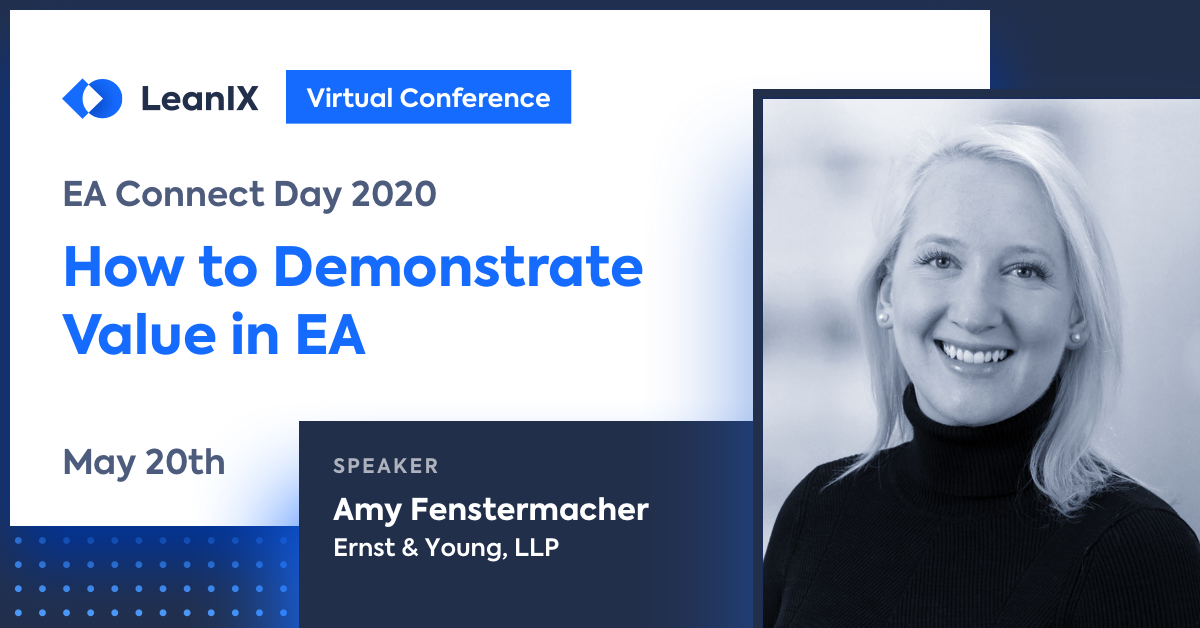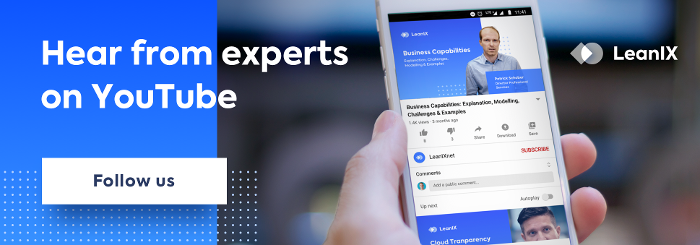
Ernst & Young’s Amy Fenstermacher spoke last month at LeanIX’s EA Connect Day on the subject of how enterprise architecture (EA) can take a greater role in leading business and digital transformations.
An EA who has spent more than a decade helping clients from the public sector modernize their capabilities, Amy knows exactly how difficult it is to prove the discipline's return on investments.
In her view, this is partly due to the fact EA focuses on the future and is so often steeped in theoretical concerns that occasionally fail to make long-lasting, fundamental changes to enterprises.
“By its very nature, EA acts as a rising tide,” Amy said. “When done well, the operational efficiency, decision-making process, and delivery of capabilities all improve. But it’s hard to attribute this to enterprise architecture.”
This is why Amy proposes the following five-point approach to driving and showing the value in EA — aptly titled the “C-O-U-N-T” method.
1. Continuous
Deliver value early and often
First, EAs need to step away from the idea that EA is something that can be “delivered.” An expectation of evolution needs to be established: EA should grow with an organization — starting out as conceptual and visionary — and then take shape through continuous pruning and refinement. Delivery successes will happen at the project or program level, Amy informs, and new capabilities can be assured to offer new opportunities.
To focus priorities at such an early stage, interactive visuals and mock-ups of future states are needed to clearly demonstrate to stakeholders, bit by bit (or business process by business process), how their worlds will change with the arrival of new standards.
2. Obvious
Speak directly to business impact
EA needs to talk directly about how the business will be impacted by a transformation in order to demonstrate explicit business value. This means that the intended outcomes and benefits of EA need to be defined while setting up enterprise architecture metrics, and the easiest way to do so is by connecting the results to financial figures or to a business’s wider strategic roadmap.
Over the past decade, the proliferation of cost-based metrics has made its way to even public sector companies. Now, during architectural reviews for government agencies, Amy has been able to integrate the highly-differentiated total cost of ownership assessments during architectural reviews based on items as unique as “user frustration” — all of which ultimately demonstrate the value of the EA program.
3. Useful
Roadmaps over diagrams
At its core, EA should be useful. It’s a basic truth that is self-evident to most EAs but not always so easy, perhaps, for others in an organization to see. To remain useful, Amy recommends employing transformation roadmaps over diagrams in order to better relate new or modified IT artifacts to a business’s long-term vision. Doing so helps organizations maintain a sense of direction and urgency, and Amy recommends including alongside each artifact a series of questions/answers to add context on how each item will be used.
4. Novel
Get back to the future
Use the future state as the basis for evaluating the current state. If fundamental transformation is wanted, Amy recommends defining new architectures via targets far enough from the current state so that the current state baseline doesn’t inadvertently narrow the transformation’s scope.
“Future-first architecture design demonstrates value much faster than the traditional approach of first analyzing the current business, data, application, and technology architectures and then moving forward to the future state,” explained Amy.
This approach nonetheless requires creativity and multimodal thinking — a demand encompassing not only technical and business awareness, but also elements of behavioral and organizational psychology. Amy recommends leveraging micro-architectural assessments to build trust, beginning with capabilities familiar to stakeholders to “tease out” a future vision and gap analysis for that specific segment or domain.
5. Tangible
Think strategically; act tactically
“Roll up your sleeves,” Amy advised. In order to actually execute transformation tasks, EAs need to embed themselves within the teams actually implementing the transformation tasks to ensure the EA vision remains understandable, achievable, realistic, visible, and consistent.
This doesn’t necessarily mean getting into the weeds and taking on engineering or developer tasks. It just means associating all technical requirements — albeit in an agile manner — to a larger purpose. EAs are uniquely positioned to ensure that the requirements of a business can always complement the knowledge of developers and designers. Same, too, for helping business and product owners prioritize their needs effectively and clarify outcomes.
Overall, Amy's advice is designed to help further close the gap between EA and its ability to lead structural, paradigm-shifting transformations. If you'd like to hear more about the C-O-U-N-T method for driving value with EA, have a look at the recording of the presentation from LeanIX's EA Connect Day below:
.png?width=140&height=107&name=BTMPlaybook-FI%20(1).png)

